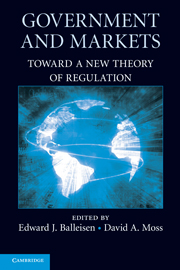Book contents
- Frontmatter
- Contents
- Acknowledgments
- Contributors
- Introduction
- SECTION I BEYOND MARKET FAILURE
- SECTION II BEYOND THE ECONOMIC THEORY OF POLITICS
- 6 The End of Special Interests Theory and the Beginning of a More Positive View of Democratic Politics
- 7 Public Choice: A Critical Reassessment
- 8 The Paranoid Style in the Study of American Politics
- 9 Law, Policy, and Cooperation
- SECTION III BEYOND COMMAND AND CONTROL
- Conclusion
- Index
- References
6 - The End of Special Interests Theory and the Beginning of a More Positive View of Democratic Politics
Published online by Cambridge University Press: 20 January 2010
- Frontmatter
- Contents
- Acknowledgments
- Contributors
- Introduction
- SECTION I BEYOND MARKET FAILURE
- SECTION II BEYOND THE ECONOMIC THEORY OF POLITICS
- 6 The End of Special Interests Theory and the Beginning of a More Positive View of Democratic Politics
- 7 Public Choice: A Critical Reassessment
- 8 The Paranoid Style in the Study of American Politics
- 9 Law, Policy, and Cooperation
- SECTION III BEYOND COMMAND AND CONTROL
- Conclusion
- Index
- References
Summary
Public choice (sometimes known as rational choice) assumes that individuals act to promote their own interests. From this simple assumption, a large body of theoretical and empirical work has been spawned. Much of this research shows that bureaucrats, politicians, and pressure groups get their way at the expense of the voters and that regulation reflects the desires of these concentrated interests rather than the appropriate balancing of all the costs and benefits. But if one really believes in the economic model of behavior, then one should be skeptical of such results. After all, it was Adam Smith who showed that the self-interest of the baker and the candlestick maker leads them to provide what consumers desire. So by the same economic logic, one should expect that the invisible hand works for the democratic political system, as well. Now there are counter arguments to this last statement, but in this chapter I counter these counter arguments by using standard economic theory and methodology. Along the way, I show that many of the negative results arise because the authors (1) have incorrectly assumed that the political system is characterized by monopoly rather than by competition, and (2) have implicitly assumed that voters are irrational, which, of course, is contrary to the rational choice paradigm. The arguments that I use against the theory of special interests can also serve as the foundation for a theory that democratic markets are well served by the invisible hand.
- Type
- Chapter
- Information
- Government and MarketsToward a New Theory of Regulation, pp. 193 - 212Publisher: Cambridge University PressPrint publication year: 2009
References
- 3
- Cited by



